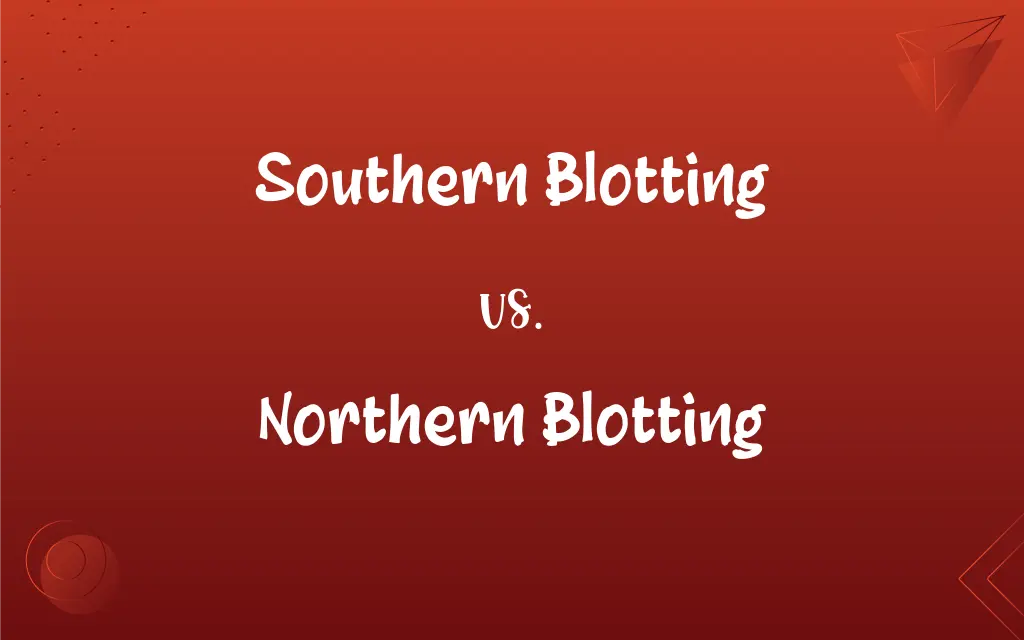Southern Blotting vs. Northern Blotting: What's the Difference?
Edited by Janet White || By Harlon Moss || Updated on October 16, 2023
Southern blotting detects DNA; northern blotting, RNA. Both are lab methods to identify specific sequences in samples.

Key Differences
Southern blotting is a technique used in molecular biology to detect the presence of a particular DNA sequence in a DNA sample. In contrast, northern blotting is used to detect specific sequences of RNA in a sample of RNA. Both southern blotting and northern blotting are used to identify and measure the presence of genetic material, but they target different types of nucleic acids.
The process of southern blotting involves transferring DNA from a gel to a membrane, followed by detection with a specific probe. Conversely, northern blotting involves a similar process but with RNA. While both techniques involve the transfer of genetic material to a membrane, southern blotting focuses on DNA, and northern blotting focuses on RNA.
Southern blotting is often used in gene discovery, mapping, and diagnostics. On the other hand, northern blotting is frequently employed in studying gene expression levels in different tissues or under different conditions. Both southern blotting and northern blotting can be essential tools for researchers, but they provide insights into different aspects of cellular function.
The probes used in southern blotting are designed to be complementary to the DNA sequence of interest. In contrast, the probes used in northern blotting are complementary to the RNA sequence of interest. Both southern and northern blotting require the use of probes that specifically bind to the target sequences, but the nature of the probe depends on the type of nucleic acid being studied.
Southern blotting and northern blotting both require the use of electrophoresis to separate nucleic acid fragments before they are transferred to the membrane. However, the type of gel used differs; southern blotting typically uses agarose gel, while northern blotting often uses polyacrylamide gels or agarose gels that contain formaldehyde to denature the RNA.
ADVERTISEMENT
Comparison Chart
Type of Nucleic Acid
DNA
RNA
Common Usage
Gene mapping, diagnostics
Studying gene expression
Type of Probe
DNA probes
RNA or DNA probes
Electrophoresis Gel
Agarose gel
Polyacrylamide/agarose gel
Detection
Specific DNA sequences
Specific RNA sequences
ADVERTISEMENT
Southern Blotting and Northern Blotting Definitions
Southern Blotting
A diagnostic tool in molecular biology for DNA sequence detection.
Doctors use southern blotting to test for specific genetic disorders in patients.
Northern Blotting
A molecular biology technique for RNA size and sequence analysis.
Researchers use northern blotting to determine the size and quantity of RNA expressed from different genes.
Southern Blotting
A method that transfers DNA fragments from a gel to a membrane for analysis.
Southern blotting helped visualize the DNA fragments resulting from the restriction digestion.
Northern Blotting
A tool for studying the regulation of gene expression at the RNA level.
With northern blotting, scientists can observe changes in RNA levels in response to environmental changes.
Southern Blotting
A procedure for DNA sequence identification using hybridization of probes.
Through southern blotting, the researchers were able to identify the target DNA sequence in the genome.
Northern Blotting
A method where RNA is transferred from a gel to a membrane for probe hybridization.
Using northern blotting, we analyzed the RNA transcripts produced by the cells.
Southern Blotting
A laboratory method for DNA fragment analysis after gel electrophoresis.
Following the electrophoresis, southern blotting was employed for further DNA analysis.
Northern Blotting
A laboratory procedure to identify specific RNA molecules among a mixture.
Northern blotting was crucial in identifying the RNA molecules responsible for the observed effects.
Southern Blotting
A technique for identifying specific DNA sequences in DNA samples.
Using southern blotting, we confirmed the presence of the gene mutation in the sample.
Northern Blotting
A technique used to study gene expression by detection of RNA sequences.
Northern blotting showed different expression levels of the gene under various conditions.
FAQs
What is southern blotting?
Southern blotting is a technique for detecting specific DNA sequences in a sample.
What is northern blotting?
Northern blotting is a method for detecting specific RNA sequences in a sample.
How accurate is southern blotting?
Southern blotting is highly accurate for detecting specific DNA sequences when done correctly.
Can southern blotting be used for RNA?
No, southern blotting is specifically designed for DNA analysis.
Is northern blotting reliable?
Yes, northern blotting is a reliable technique for studying RNA sequences and gene expression.
Does southern blotting require prior knowledge of the DNA sequence?
Yes, a sequence-specific probe is required, so prior sequence knowledge is necessary.
Can you perform northern blotting without knowing the RNA sequence?
No, you need to know the sequence to create a complementary probe for detection.
Can northern blotting detect DNA?
No, northern blotting is used exclusively for RNA detection.
How do you see RNA in northern blotting?
Labeled probes hybridize to target RNA in northern blotting, and the signal is visualized using various detection methods.
Can southern blotting be automated?
While traditionally labor-intensive, newer technologies and methods are enabling automation of southern blotting.
Is there a rapid method for northern blotting?
Traditional northern blotting is time-consuming, but newer techniques and kits offer more rapid options.
Are there alternatives to southern blotting?
Yes, PCR and DNA microarrays are modern alternatives that are often quicker and more sensitive.
Why is the name "northern" blotting used for RNA detection?
The name "northern" blotting was chosen as a playful contrast to "southern" blotting, reflecting its use for RNA instead of DNA.
What are the applications of southern blotting?
Southern blotting is used in gene discovery, mapping, forensics, and genetic disorder diagnostics.
Where is northern blotting commonly used?
Northern blotting is often used in molecular biology research, particularly in studying gene expression.
How is DNA visualized in southern blotting?
In southern blotting, labeled probes hybridize to the target DNA and are detected by autoradiography or other methods.
What's the purpose of the probe in southern blotting?
The probe in southern blotting binds to and marks the specific DNA sequence being sought.
Why are probes necessary in northern blotting?
In northern blotting, probes identify and bind to target RNA sequences for detection.
What can be used instead of northern blotting?
Alternatives like RT-PCR, RNA-seq, and microarrays can be used for similar purposes with different advantages.
Why is it called "southern" blotting?
Southern blotting is named after its inventor, Edwin Southern.
About Author
Written by
Harlon MossHarlon is a seasoned quality moderator and accomplished content writer for Difference Wiki. An alumnus of the prestigious University of California, he earned his degree in Computer Science. Leveraging his academic background, Harlon brings a meticulous and informed perspective to his work, ensuring content accuracy and excellence.
Edited by
Janet WhiteJanet White has been an esteemed writer and blogger for Difference Wiki. Holding a Master's degree in Science and Medical Journalism from the prestigious Boston University, she has consistently demonstrated her expertise and passion for her field. When she's not immersed in her work, Janet relishes her time exercising, delving into a good book, and cherishing moments with friends and family.
































































